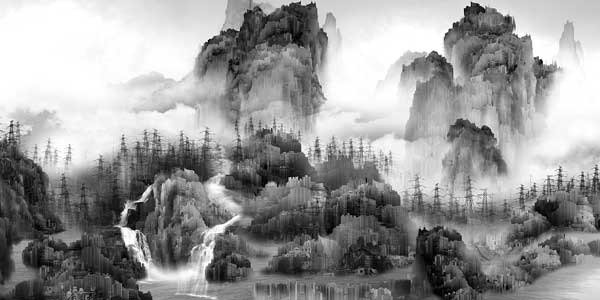Shanshui
dal 19/5/2011 al 1/10/2011
Segnalato da
Ai Weiwei
Duan Jianyu
Feng Mengbo
Hu Liu
Huang Yan
Yang Yongliang
Yuan Xiaofang
Zhang Xiaotao
Yangjiang Group
Ai Weiwei
Peter Fischer
Uli Sigg
19/5/2011
Shanshui
Kunstmuseum Luzern, Luzern
The exhibition looks at the relationship Chinese contemporary art has shaped to its own tradition through the lens of the landscape painting. The initially apparent idyll quickly disperses in light to its own history and culture since the first World War. The volatility of this idyllic motif quickly becomes evident as a burning issue of great importance even today.

Curated by Ai Weiwei, Peter Fischer & Uli Sigg
In China, shanshui has been developing as a form of artistic expression for more than 1’500 years. This painterly form, which literally translated means “mountain-water-painting,” is part of humanity’s cultural heritage. As the joint Swiss-Chinese project delved into the topic, and especially into the question of shanshui’s continued relevance for a contemporary context, it encountered a highly complex field of research.
At one pole of this significantly joint venture stands Uli Sigg, he is the Swiss expert on China, to this day, Sigg has built up the most extensive collection of Chinese contemporary art in the world. Ai Weiwei stands at the other pole. The Chinese conceptual artist, architect and activist has long been a mentor to the present day Chinese art scene. These two border walkers come together in the Museum of Art Lucerne, which, situated on the Lake Lucerne shoreline, is an ideal location to reflect on landscape in the sense of shanshui, as an expression of the soul.
The exhibition Shanshui looks at the relationship Chinese contemporary art has shaped to its own tradition through the lens of the landscape painting. The initially apparent idyll quickly disperses in light to its own history and culture since the first World War. The volatility of this idyllic motif quickly becomes evident as a burning issue of great importance even today.
The exhibition combines 70 major works from the Sigg Collection, all dated between 1994 to 2011. In addition to international stars such as Ai Weiwei, Huang Yan, Liu Wei, Qiu Shihua or Zhou Tiehai, the younger generation of artists, including for the first time a significant number of female artists, are present with surprisingly innovative concepts: Chen Ke, Hu Liu, Li Xi, or Ni Youyu, to mention just a few, are all around 30 years old and are certainly among the major discoveries of this exhibition. However, unlike their predecessors, the engagement of this younger generation with its roots is not obscured by any undue fascination for Western artistic strategies. With great freedom, these artists create an inspiring mixture of traditional and modern artistic concepts using widely different media. In this manner they bring the philosophical and spiritual dimension of traditional Chinese culture into the current day to preserve it for the future.
To introduce the “uninformed Western mind” (an allusion to the title of an informative conversation between Uli Sigg and the Chinese art historian Hu Mingyuan published in the exhibition catalogue) to the delights of shanshui painting, the exhibition includes a brief survey of Chinese landscape painting that spans the last 1000 years. The eleven outstanding loans from the Rietberg Museum in Zurich, the Musée Guimet in Paris and M K Lau Collection; Hong Kong, gathered in this cabinet warrant the visit to the exhibition on their own.
Artists of the exhibition: Ai Weiwei, Chen Guanghui, Chen Huang (17. Jh.), Chen Ke, Dai Guangyu, Dong Qichang (1555–1636), Duan Jianyu, Feng Mengbo, Fu Baoshi (1905–1965), Gu Wenda, Guo Xi (nach Guo Xi, 1020–1090), He Xiangyu, Hong Lei, Hu Liu, Huang Shen (1687–1772), Huang Yan, Ji Dachun, Jiang Zhi, Jin Jiangbo, Li Keran (1907–1989), Li Xi, Liu Wei, Liu Wei, Mi Wanzhong (1570–1628), Ni Youyu, Peng Wei, Qiu Anxiong, Shang Yang, Shao Wenhuan, Shen Zhou (15. Jh.), Shi Guorui, Wang Hui (1632–1717), Wang Yin, Wen Zhengming (1470–1559), Wu Gaozhong, Xu Bing, Xu Xiaoguo, Yan Lei, Yang Yongliang, Yao Song (1648–1721), Yuan Xiaofang, Zhan Wang, Zhang Jianjun, Zhang Xiaotao, Zhao Mengfu (zugeschr. 1254–1322), Zheng Guogu, Zhou Tiehai.
Opening: Friday May 20 at 6.30pm
Kunstmuseum Luzern
Europaplatz 1, Luzern
Opening Hours: Tuesday, Wednesday 10am-8pm
Thursday to Sunday 10am-6pm



